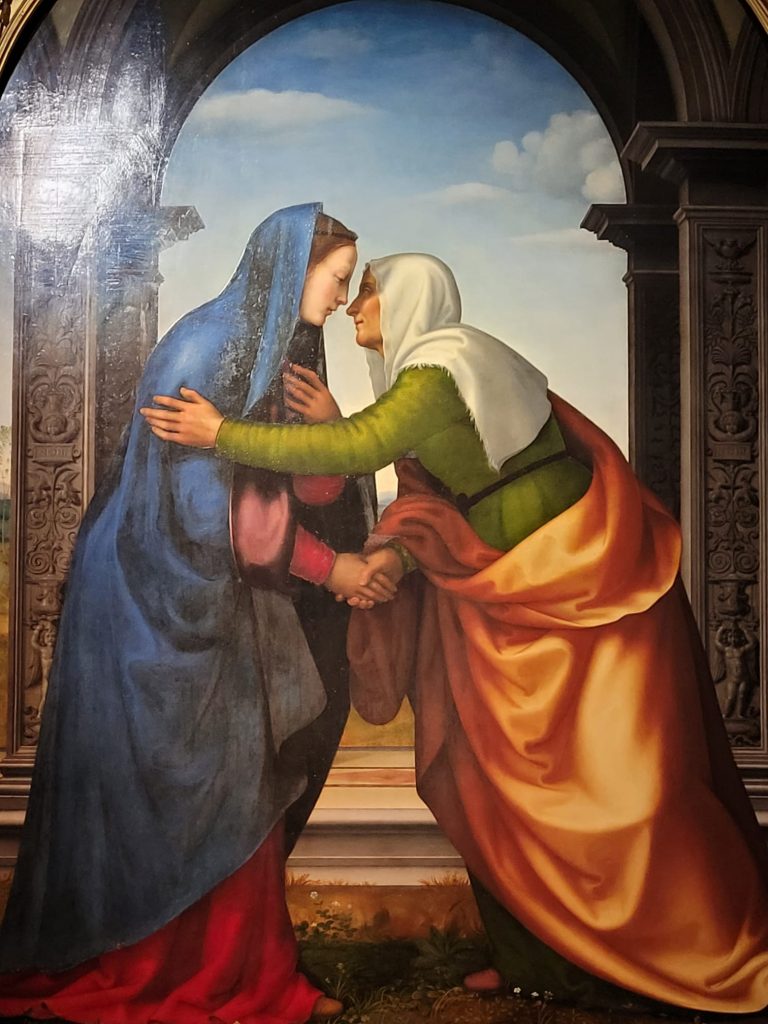Theology Corner
A Person of Refuge
It has been a while since we last updated our theology corner, and my recent trip to Italy has provided just the inspiration. As some of you know, by a rather convoluted set of circumstances, my brother and I spent four days in Florence looking at art.
By way of introduction, my brother and I are not artists or experts in fine art. Like many children of the 80’s, our first introduction to the Renaissance masters came courtesy of the Teenage Mutant Ninja Turtles. So, what follows is not a high-brow critique, but rather, a comment about a piece of art I found moving.
Here it is …

This is called Visitation, by Mariotto Albertinelli, painted in 1503.
Now one thing Florence is not short of is paintings of the Blessed Virgin Mary. And while I am not Philistine enough to say: “seen one you’ve seen them all!” – you have to admit, by the time you have seen 50 such masterpieces in half an hour, one becomes somewhat immune to their intended effect. (Maybe this is the problem with encountering these paintings in a gallery rather than a church.) However, this painting of Mary made me stop in my tracks.
Part of its power, I think, is because it depicts a lesser explored chapter of Mary’s life. It’s called the Visitation, and it refers to Mary’s trip to visit her older relative Elizabeth. In this scene, both women are pregnant; both pregnancies would have been the subject of village gossip. The New Testament tells us that Elizabeth, and her husband Zechariah, were both “very old.” Let’s not be prudish, we all know the mechanics of the situation, Elizabeth’s pregnancy would have been a surprise, miraculous even, but no one would have thought it scandalous. But Mary was different.
In the preceding passage, (referred to in art, liturgy, and literature as the “Annunciation”) the angel Gabriel is sent to Mary with the following announcement:
“Do not be afraid, Mary; you have found favour with God. You will conceive and give birth to a son, and you are to call him Jesus. He will be great and will be called the Son of the Most High. The Lord God will give him the throne of his father David, and he will reign over Jacob’s descendants forever; his kingdom will never end.”
As a Christian, I believe in the virgin birth. But I do not for a minute, expect people to find it an easy point of Christian belief to accept. What’s more, I do not think that this claim seemed any more credible to people 2000 years ago than it does to us today. Instead, I think the Annunciation would have absolutely turned Mary’s life upside-down. In an honour based culture in the ancient world, this news would have been shattering. Mary is presented to us as an example of faith, not because she passively accepted the angel’s news, but because she courageously carried within her the message of the gospel against the dangers, scandal, and judgement of her society. Mary is the Bible’s idea of strength.
But even the strong struggle. Albertinelli’s Visitation captures the moment Elizabeth receives Mary, who is weeping. Mary is being swept up into the care of a maternal figure, who as far as we know at this point, is the only person to believe Mary is telling the truth. It is a scene of sanctuary and refuge. Look again at the picture, and you will see that Albertinelli is deliberately playing with perspective:

Who is in the foreground? From their faces it’s Mary, and yet Elizabeth’s outstretched arm is closest to us. The competing perspective tells us that even carers need to be cared for, even the greatest among us need to be looked after. Even Mary needed a place (or rather, a person) of refuge.
As we approach Advent, here’s a question to ponder: what might it mean to be an Elizabeth for somebody? What might it look like to be that person of sanctuary for those who are struggling?
With warmest wishes
Rev. Simon

